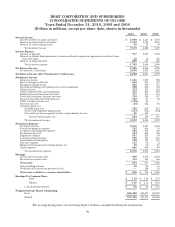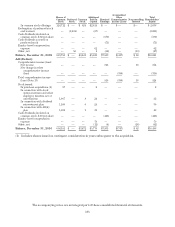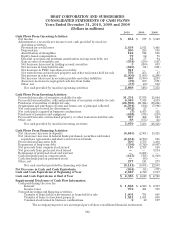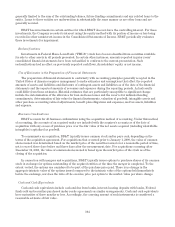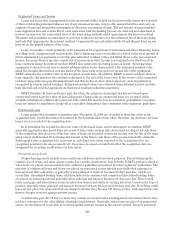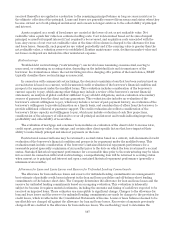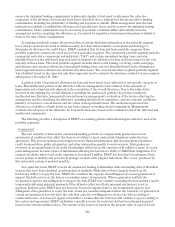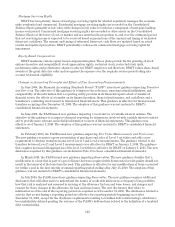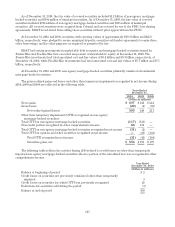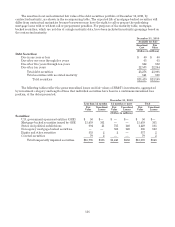BB&T 2010 Annual Report Download - page 109
Download and view the complete annual report
Please find page 109 of the 2010 BB&T annual report below. You can navigate through the pages in the report by either clicking on the pages listed below, or by using the keyword search tool below to find specific information within the annual report.
flows discounted at the loan’s effective interest rate, and/or the value of collateral. BB&T has also established a
review process related to restructurings and other impaired loans that are in commercial lending relationships
with outstanding debt of less than $2 million at the balance sheet date. In connection with this process, BB&T
establishes reserves related to these loans that are calculated using an expected cash flow approach.
BB&T also maintains reserves for collective impairment that reflect an estimate of losses related to
nonimpaired commercial loans as of the balance sheet date. Embedded loss estimates for BB&T’s commercial loan
portfolio are based on estimated migration rates, which are estimated based on historical experience, and current
risk mix as indicated by the risk grading process described above. Embedded loss estimates may be adjusted to
reflect current economic conditions and current portfolio trends including credit quality, concentrations, aging of
the portfolio, and significant policy and underwriting changes.
Retail
The majority of the allowance for loan and lease losses related to the retail lending portfolio is calculated on a
collective basis using a delinquency-based approach. Embedded loss estimates for BB&T’s retail lending portfolio
are based on estimated migration rates that are developed based on historical experience, and current risk mix as
indicated by prevailing delinquency rates. These estimates may be adjusted to reflect current economic
conditions and current portfolio trends. The remaining portion of the allowance related to the retail lending
portfolio relates to loans that have been deemed impaired based on their classification as a restructuring at the
balance sheet date. BB&T establishes specific reserves related to these restructured loans using an expected cash
flow approach.
Acquired Loans
For loans acquired in a business combination after December 31, 2008, BB&T has generally aggregated the
purchased loans into pools of loans with common risk characteristics. In determining the allowance for loan and
lease losses, BB&T performs an analysis each period to estimate the expected cash flows for each of the loan
pools. To the extent that the expected cash flows of a loan pool have decreased since the acquisition date, BB&T
establishes an allowance for loan losses.
Covered Assets and Related FDIC Loss Share Receivable
Assets subject to loss sharing agreements with the Federal Deposit Insurance Corporation (“FDIC”) are
labeled “covered” on the balance sheet and include certain loans, securities and other assets.
The fair value of the reimbursement the Company expected to receive from the FDIC under those
agreements was recorded in the FDIC loss share receivable at the date of acquisition on the Consolidated
Balance Sheets. The fair value of the FDIC loss share receivable was estimated using a discounted cash flow
methodology. The discount rate used in this calculation is determined using a risk-free yield curve plus a premium
reflecting the uncertainty related to the timing of cash flows. The income statement effects of the FDIC loss
share receivable is included in noninterest income and includes the accretion due to discounting and changes in
expected reimbursements. Decreases in expected reimbursements are recognized in income prospectively
consistent with the approach taken to recognize increases in cash flows on covered loans. Increases in expected
reimbursements are recognized in income in the same period that the allowance for credit losses for the related
loans is recognized.
Premises and Equipment
Premises, equipment, capital leases and leasehold improvements are stated at cost less accumulated
depreciation or amortization. Land is stated at cost. In addition, purchased software and costs of computer
software developed for internal use are capitalized provided certain criteria are met. Depreciation and
amortization are computed principally using the straight-line method over the estimated useful lives of the
related assets. Leasehold improvements are amortized on a straight-line basis over the lesser of the lease terms,
including certain renewals that were deemed probable at lease inception, or the estimated useful lives of the
improvements. Capitalized leases are amortized by the same methods as premises and equipment over the
estimated useful lives or lease terms, whichever is less. Obligations under capital leases are amortized using the
interest method to allocate payments between principal reduction and interest expense. Rent expense and rental
income on operating leases is recorded using the straight-line method over the appropriate lease terms.
109


